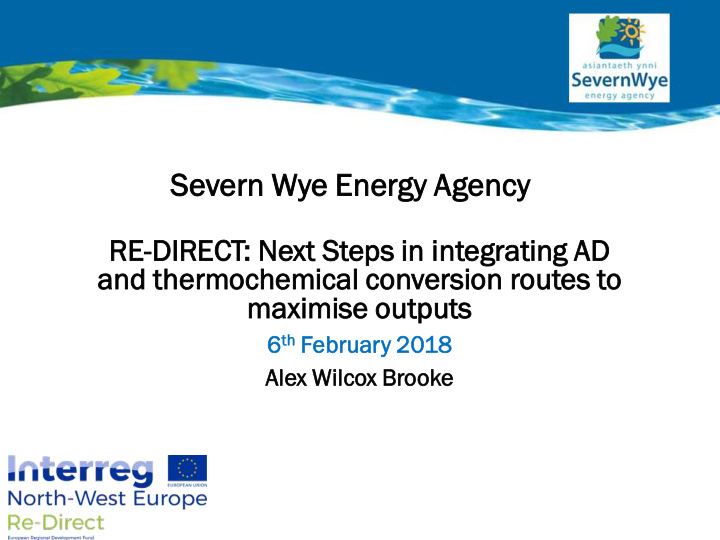



Severn ern Wye Energ rgy y Agency cy RE RE-DIRE DIRECT: Next Steps ps in integ egrat atin ing AD and thermoc rmochem emica cal l conver ersi sion on routes es to maxim ximise ise outpu puts th Februar 6 th ruary 2018 Alex Wilcox Brooke
The Proj ojec ect Regional Development and Integration of unused biomass wastes as Resources for Circular products and economic Transformation (Re-Direct) Backgroun ound There are 34 MT of residual biomass across the North West Europe partner regions involved. At present this is either left to rot, burnt on site or transported for low value product.
Aims ms • Increase the resource efficiency by transforming residual biomass into a high-quality product; • Develop regional-specific biomass portfolios and integrated biomass concepts; • Conduct scientific investigations to underline the sustainability of the developed technology both in ecological and economical aspects; • Establish the worlds first industrial IFBB plant incl. a pyrolysis and activation unit to produce activated carbon; • Investigate opportunities for applying the technology decentrally in rural areas; • Explore the effects on disadvantaged areas in terms of creating new green jobs.
Prograss ograss Integrated approach, conserving semi-natural grasslands whilst generating energy sustainably. Characterised by a high proportion of lignocellulose and minerals. Difficult to use in conventional systems like biogas production or hay combustion.
Comb mbine Producing storable solid fuel with a highly energy-efficient process Utilising biomass from extensively used grassland areas and landscape management, which can neither be used in animal feeding nor in conventional energetic conversion technologies Increasing the efficiency of biomass supply chains, through the addition of a year-round heat sink in distributed biogas or AD plants and by new harvesting and conditioning techniques. Creating new energy supply chains from biomasses in the project regions and beyond Securing livelihood for small farmers and disadvantaged persons in retreated areas through the creation of new income sources and regional added values with renewable energy production Contributing to reducing the conflict between bio-energy and food production by exploring and utilisation of new raw materials.
IFBB technolog hnology
Conclus lusion ions:
Conclu lusion sions s cont. t. Both environmental and economic benefits Concerns over technologies implementation in the UK due to: • Waste regulations • Water requirements of IFBB • Accreditation of fuel and boilers
The techn hnology; ology; IFBB – Intergrat ergrated ed Generati eration on of Solid id Fuel l and Biogas as from Biomas ass – extende nded d with h pyroly olysis is and activ ivati ation on unit
The Re-Di Direct ect system • Washing of the samples • Hydrothermal conditioning • Mechanical dewatering • Sample preparation • Slow pyrolysis • Activation
What at does s that t mean in practice tice? • An on farm IFBB pilot plant in Wales. A replicable sustainable model for the production of • added value carbon products from waste biomass. • Environmental benefits • Economic benefits
Challeng llenges es & Barrier iers • New technology Upfront costs • • Sustainability of feedstock • Additional land management • Industry stability
What' at's s next? • Development of the pilot on farm IFBB plant • Identify sustainable feedstock • Identify product chains • Identify new regions and partners interested in the technology • Develop a realistic & sustainable model for Wales
Thank you for listening Alex Wilcox Brooke AlexW@severnwye.org.uk www.re-direct-nwe.eu www.severnwye.org.uk
Recommend
More recommend